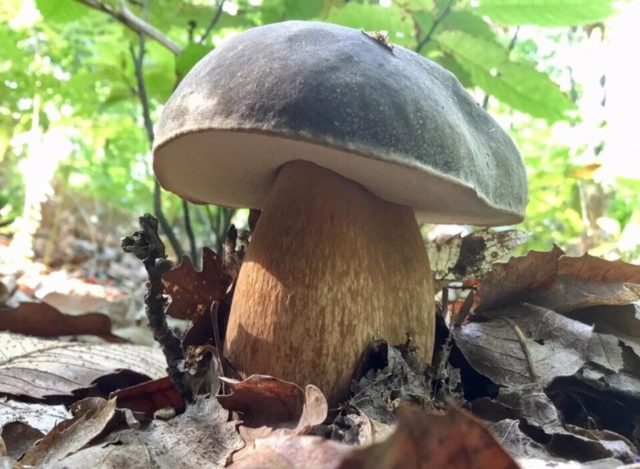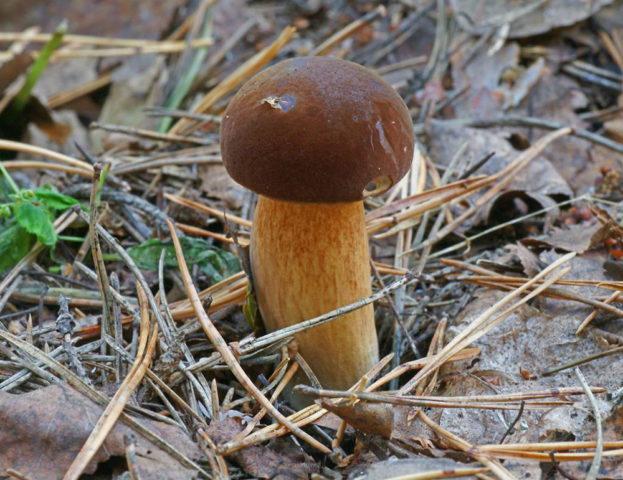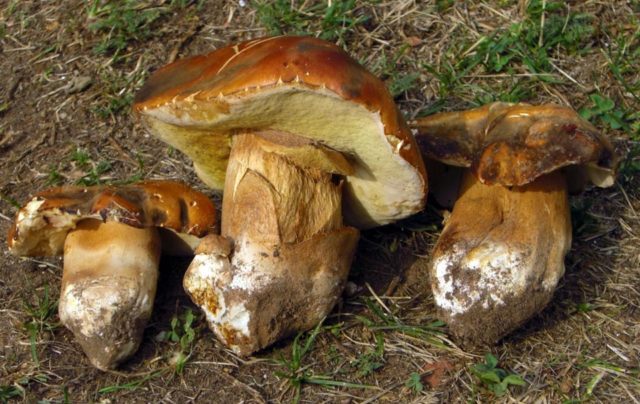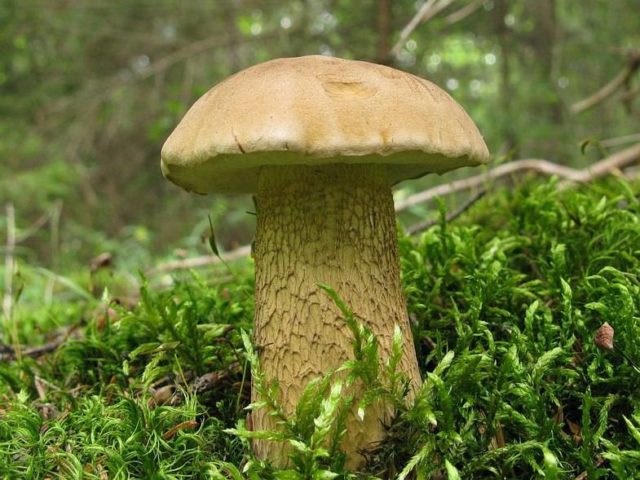Content
Bronze boletus is a suitable for consumption, but rather rare mushroom with autumn fruiting. To correctly distinguish a bronze boletus in the forest, you need to study its description and photo.
What bronze pains look like
Bronze pain has a rather large cap, on average about 17 cm in diameter, the thickness of the cap is up to 4 cm. At a young age, the shape of the cap is convex and almost spherical, but over time it straightens and becomes prostrate. In young fruit bodies, the surface of the cap is smooth; with age, uneven depressions appear on it, located mainly closer to the edges.
Bronze sore has a dark chestnut, almost black cap at a young age. At the same time, there are areas with a whitish bloom on it, this feature is characteristic of the bronze boletus. As it grows older, the hat lightens a little and becomes chestnut or brown with a copper tint. You can also recognize a bronze sore by the sign that his hat is always dry. It does not become mucous even with high humidity.
The underside of the cap is covered with tubes with small angular pores. In young fruit bodies, the tubular layer is white or grayish-white; with age, it acquires a pale yellow or cream shade, and becomes olive yellow with age. If you press on the tubular layer, then a dark spot will quickly appear at the point of contact.
The boletus can rise up to 12 cm above the ground, the leg thickness is 4 cm. The leg is thick in shape, with a compaction at the bottom, clavate or tuber-like, and with age it acquires a cylindrical shape. The surface of the leg is wrinkled and hard to the touch. Young mushrooms have almost white legs, but with age, the color changes to pinkish-beige or olive-beige, with a brown bottom.
If you cut it on the cap, then the flesh will turn out to be dense and uniform wine-red color, if the fruit body is young. In old fruit bodies, the flesh is almost white, yellowish closer to the tubes and softer. At the break, the pulp quickly darkens, the pain has a neutral smell and taste.
Where bronze boletus grow
You can rarely meet a bronze boletus on the territory of Russia. It mainly grows in southern regions with a warm climate on moist humus soils. It grows mainly in mixed forests with the presence of beech or oak, it also comes across under pine trees. You can see the pain both alone and in small groups of 2-3 copies.
Is it possible to eat bronze bolts
Bronze boletus belongs to the edible category. It is actively consumed in the Mediterranean countries, where bronze ailments are not uncommon. It is suitable for all processing methods and can be eaten boiled, fried, dried and frozen.
The palatability of the mushroom hurts bronze
Boletus of this type is classified as a delicacy. According to gourmets, its taste surpasses even the taste of porcini mushroom in terms of brightness and saturation.
False doubles
Bronze has no toxic inedible counterparts. But this mushroom can be confused with some edible varieties.
Polish mushroom
The pain has a certain similarity with the edible Polish mushroom - in adult fruiting bodies, there is also a cylindrical dense leg, crowned with a hemispherical or pillow-shaped cap of a red-brown, chocolate or chestnut shade.
You can distinguish the varieties among themselves mainly by the absence of a mesh on the leg of the Polish mushroom. In addition, if you cut the fruit body, then its white pulp will turn blue very quickly from interaction with air.
Semi-bronze ache
The semi-bronze boletus has a strong resemblance to the bronze bolt. The varieties are very similar to each other in structure and size, they have the same caps in shape. The main difference lies in the shade of color - the semi-bronze one hurts lighter, its cap is usually gray-brown, with yellowish spots.
Pine porcini mushroom
The edible white pine mushroom is often confused with other representatives of boletus, including the bronze boletus. But unlike the bronze boletus, white pine grows only in coniferous forests and is not found in deciduous ones. In addition, his hat is wine-red or brown-red, and in terms of the size of the cap and legs, he is larger than the bronze one.
Gall mushroom
Very often boletus, including bronze, on the territory of Russia is confused with a gall mushroom. Gorchak has a very similar structure and can be almost indistinguishable from bronze pain. But it can be recognized by the unique structure of the leg - in the bitter pot, it is covered with pronounced vascular veins.
Although the gall fungus is not poisonous, it is not suitable for human consumption. The bitter taste of the mushroom can spoil any dish, and the bitterness is not eliminated either by soaking or boiling.
Collection rules
You should look for it in the woods closer to autumn, in mid-August or even in early September. At this time, it is found most often, although it still remains rare and comes across only in the southern regions.
It is necessary to choose only clean forests located at a distance from the roads to collect the pain. In the vicinity of highways and industrial facilities, mushrooms absorb too many toxic compounds - it becomes unsafe to eat them.
When collecting pains, you need to use a sharpened knife or twist the fruit body out of the ground and try not to damage the mycelium. If you just pull the pain out of the soil, then later it is unlikely to grow in the same place.
Use
The edible pain is good for eating in any form. It cannot be eaten raw, but after boiling it can be added to other dishes or fried and marinated. Boletus can also be dried, which will preserve its taste and useful properties for many months.
Before frying or pickling, the pain is subjected to a short treatment.The pulp must be cleaned of all adhering debris, rinsed with cool water and cut off the lower part of the leg. After that, the pain is soaked in cold water for 15 minutes, and then boiled with salt for 20 minutes if the mushrooms are planned to be fried, and 40 minutes for pickling or boiled.
Conclusion
Bronze boletus is an edible mushroom that can be found in the southern regions of Russia. According to gourmets, it tastes even more delicious than the famous porcini mushroom and has many health benefits when consumed.















